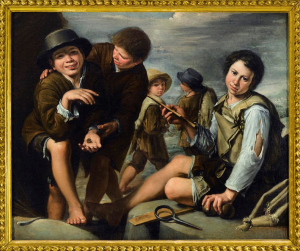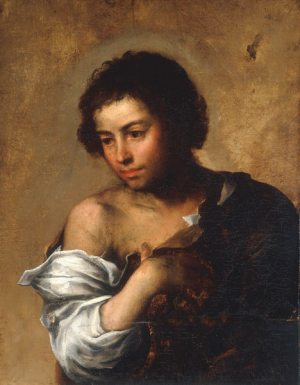(Boylove Documentary Sourcebook) - Age-Structured Male Homosexual Activity in Early Modern Spain

From Sexual Hierarchies, Public Status: Men, Sodomy, and Society in Spain's Golden Age by Cristian Berco (Toronto: University of Toronto Press, 2007). Footnotes omitted.
Although scholarship on same-sex erotic behaviour in early modern Spain has recently witnessed a veritable surge after years of scarcity when research on homosexuality seemed to reflect the pre-modern dictum of homosexual behaviour and sodomy as unspeakable, few studies have approached the topic by delineating the gendered construction of a system that often rested on age hierarchies as the model for sexual behaviour between men. Whereas scholars have employed the tool of gender analysis in their investigation of sodomy and queer discourses, they have mostly shied from examining age differences as a factor that informed same-sex erotic behaviour.
Historians of Spain, however, do not exclusively bear this omission. Only a few works for the rest of Europe, especially for the early modern era, have actually tackled the issue of age differences and dominance as factors of sexual encounter. With the emergence of social constructionism as a viable system of analysis, some scholars have ventured to express the prevalence of a dominating system of sexuality whereby older men usually penetrated younger adolescents for other areas of the European continent.
Michael Rocke, in his seminal Forbidden Friendships, aptly analysed the widespread sexual behaviour of Florentine adolescents in terms of long standing age hierarchies that saw the older partner as the active penetrator dominating a younger passive partner. His analysis of Florentine same-sex patterns of erotic behaviour recalls systems of sexuality that anthropologists and social theorists have observed throughout the Mediterranean and other areas of the world where masculinity played a leading role in the identity formation of men. Although others such as Saslow and Talley have also highlighted the prevalence of this form of pederasty in other areas of Europe and even North America, it remains striking that the Spanish case has received scant attention.
That early modern Spain would have been somehow wholly removed from a system in which men sexually dominated adolescents on the basis of the accrued masculinity of penetrative sexuality seems implausible considering the long tradition of pederastic behaviour that has suffused the Mediterranean world. Indeed, the cases of male homoerotic behaviour that inquisitors in the Crown of Aragon conducted reveal a strong pattern of age hierarchies as the determining factor of sexual roles. As can be gleaned from table 1, sexual roles in intercourse tended to correspond with cultural practices that designated the older partner as the inserter and dominator and the younger one as passive receptor.
While 68.5 per cent of men aged over twenty exclusively took the active role during sex, only 15.5 per cent of those aged below twenty did so. It should also be noted, that of the 107 young men who engaged in active anal sex, 92 of them (86 per cent) did so with younger partners, that is other teenagers or even children. This fact confirms the notion that sexual roles were generally tied to hierarchical concepts based on age. Thus, 70.4 per cent of younger men appearing in the cases engaged exclusively in passive sex; that is, they were approached, seduced, and sometimes raped by older men.
Although some might view these men as anomalies, unruly ‘sodomites’ and pederasts unconnected to social structure, the way these men and their adolescent partners talked about sexuality during their trials reveals a certain fatalism, a normalcy associated with the idea that men would find boys attractive. The term ‘normal’ does not imply acceptance necessarily for, after all, these men did appear before court. Rather, ‘normal’ suggests the sense of expectation surrounding this behaviour, the tinge of inevitability that coloured perceptions of this type of sexual attraction. That is, although frowned upon, nobody pulled their hair in surprise when a man attempted to seduce an adolescent, for it was expected that as sexual creatures men would desire adolescents, despite the sin such attraction might entail.
[...]
Some young men, especially those who had encountered these experiences before, were more prone to accept the advances of adults if they received a gift, be it an article of clothing, food, or money. In Valencia in 1712, fourteen-year-old Manuel Romá, a surgeon apprentice, met an Italian man named Nicola in the market and after some negotiation agreed to have sex with him. As recounted by the adolescent,
The said Nicola told him that he would give him one real if he let him stick it up his ass. [Manuel], seeing the profit in what he proposed, responded, ‘It was about time we got to this.’ And the said Nicola told him, ‘Well, then, let's go to the fish market where there are washrooms in which we can do it,’ and [Manuel] did not want to agree to go to that spot and told Nicola that the washrooms in San Juan del Mercado were a better place, where in fact they went.
Manuel’s knowledge of the various locations where the couple could engage in sexual practices relatively unmolested suggests his experience in these matters and points to the informal prostitution of young men in urban centres.
The offering of gifts, however, whether monetary or otherwise, was not merely relegated to those who more or less engaged in some sort of informal prostitution. Rather, gift-giving formed a central part of the negotiated process by which an older man sought to seduce an adolescent.
[...]
The various strategies employed by men who wished to have sex with young adolescents evince a gendered component to the active/passive dichotomy of sexual roles. We thus encounter adult men engaging in the acceptable masculine practice of seeking sexual satisfaction from an object of desire, in this case young adolescent males. However, the pursuers constantly feminized the young men and thus converted this male-to-male sexual pursuit into a mirror of male/female sexual relations.
The cajoling words, gifts, money, overt advances, and sometimes violence mimicked the relationships established between men and women. Although the mere similarity in seduction strategies between heterosexual and homosexual relationships may not necessarily render the latter an imitation of the former, the language utilized by both the active older males and the passive adolescent boys highlights the prism of gender through which these relationships were viewed.
For example, in 1621, Jaime Carrio, a forty-eight-year-old farmer in the village of Alcolecha, found himself sharing a bed with a fourteen-year-old whom he coveted. While carrying out his advances in the course of the night, Jaime kept repeating, ‘What a beautiful girl we have here.’ Likewise, in 1651, Carlos Charmarinero, an employee of the city of Valencia in charge of market security at night, had established a relationship in which money and gifts were regularly exchanged for sex with a fourteen-year-old vagrant named Miconet. Once, upon meeting his neighbours in the company of Miconet, Carlos boasted that ‘this young man served him as a woman.’ Thus, although men were certainly aware that they were sexually involved with younger males, they never considered their masculinity in jeopardy because their partners serviced them sexually as they thought a woman should.
The connection between sexual passivity and femininity constituted such a strong cultural construct, that even the passive partners often acquired, or attempted to imitate, female modes of behaviour and speech patterns, in essence conforming to dictates that emasculated them as objects of desire. The Master of Bot’s fourteen-year-old servant who was engaged in a sexual liaison with his employer once participated in a row with another comrade in the household, apparently over the attentions of the master. In a fit of rage, the young man sternly told the other boy to stay away from his ‘husband.’
[...]
The sources sometimes reveal individuals who, in their conscious avowal of a specific homosexual preference, pointed to a sexual subculture construed around the notion of same-sex eroticism. For instance, during the trial of the infamous Nicolás González, the youngster who allegedly procured young Christian adolescents to sexually service Muslim slaves in Valencia, information emerged that suggested the existence of such a subculture. According to the testimony of a teenage boy, when Nicolás introduced him to Agustín Bustamante, a squire of the Duke of Gandía, he assuaged the latter’s fear of discovery by calmly stating, in reference to the adolescent, ‘No, no, he is one of us.’ Addressing the young man’s reliability because he also engaged in sexual activity with men, Nicolás’s expression points to the possibility of an emerging homosexual subculture in early modern Valencia.
[...]
Whereas many younger men were quite willing to engage in sexual practices such as mutual masturbation that did not necessarily denote any femininity on their part, they often rejected any thought of taking the passive role in anal sex, precisely because it would mark them as an emasculated being. Thus, when a twenty-six-year-old solicited a younger man for anal intercourse, the adolescent ‘became exasperated, saying that he was not a woman to be treated in such a fashion.’ Sometimes, the mere mention of anal sex could easily result in an abrupt change of attitude. Fourteen-year-old Juan Beltrán willingly masturbated Francisco Castello, an older farm labourer, but refused to consent, even if drowned, to ‘receiving it in the behind.’ Intercourse with older men concerned more than sexuality itself, implying powerful messages on gender identity.
[...]
The precocious and often violent sexual experimentation of children and adolescents also attest to the prevalence of this system of masculine prowess based on virility and dominance. Just as adolescents were often sodomized by adult men, they themselves turned on younger children, thus perpetuating the gendered system that informed these sexual practices. During harvest in the town of San Felipe, close to Valencia, fourteen-year-old Benito Campay and his friends spent the afternoon stocking wheat into his father’s storage. After having finished the chore, the young comrades, aged respectively sixteen, fourteen, twelve, ten and nine, proceeded to undress and masturbate each other. The next afternoon, all six of them once again convened in the same storage room and started masturbating when the eldest, named Pedro Juan, ‘started to throw them face down over the wheat and sodomize them.’ Pedro Juan thus reaffirmed his hierarchical position as the eldest and introduced the younger boys to the vagaries of the dominance and submission dichotomy.
[...]
Aside from the potentially dangerous social mixing that informal prostitution could afford, the shifting relationship between the adult partner and his adolescent protégé could result in an imbalance in normal age hierarchies. As much as the paying man deployed power over the young boy with whom he slept, so could the adolescent utilize the asset of his sexual desirability to his advantage. For instance, in 1760 both Juan Laure, a soldier in the Milan regiment stationed in Zaragoza, and Miguelín, his young lover whom he maintained, wound up together in jail. In a fit over Miguelín’s supposed infidelities, Juan complained to him, ‘Oh you rotted-ass fag, going to be fornicated by Viola and Bernaze, you already know that it cost me three pesetas to cure you the first time we met, and that since we have been together you have cost me more than two thousand reales.’ Yet despite the anger, Juan seemed so taken with Miguelín that a witness testified that by December and January, Juan subsisted on only bread and water so that Miguelín could take his share of soup and wine. Likewise, during the trial of Carlos Chamarinero, witnesses testified that upon meeting Carlos’s adolescent lover, Carlos told them that he gave the young boy one real a day just so that he would remain his friend. In these relationships, power flowed uneasily between the adult and teenage partner through the axis of money and desire, so that the normal subservience that could be expected from a young man towards an adult could often fall apart.
